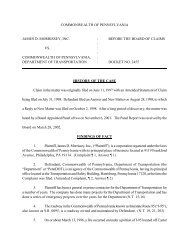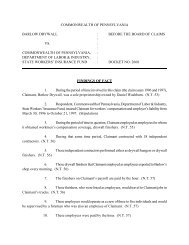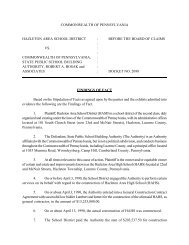3720 - Board of Claims
3720 - Board of Claims
3720 - Board of Claims
You also want an ePaper? Increase the reach of your titles
YUMPU automatically turns print PDFs into web optimized ePapers that Google loves.
had to finish that section before moving to excavate or build in the other sections. (Ex. P-2A).<br />
The construction methods to be used for the embankments were otherwise left to the contractor.<br />
(Ex. P-17; N.T. 1068, 1160).<br />
Intercounty's allegation that it incurred expenses for stockpiling and re-handling that<br />
were beyond those it would have incurred under the original Construction Sequence is simply<br />
wrong. According to Mr. Nansteel and Mr. Lizza, Intercounty originally planned to obtain<br />
embankment material for use on the Project (all sections) by taking it from a large cut area in<br />
Section Three and immediately trucking it to create the required embankments in Sections One<br />
and Two. (N.T. 357-359, 624-626). However, under the original Construction Sequence,<br />
Intercounty was required to start in Section One by building the embankments and would not<br />
have been able to excavate any material from Section Three until much later. Pursuant to the<br />
408 Specifications, Intercounty would have then had to purchase fill material <strong>of</strong>fsite at its own<br />
expense, truck it to the site and <strong>of</strong>f-load it to create the Section One embankments. The same<br />
would have been true for Section Two. When it got to Section Three, Intercounty would have<br />
had to excavate the hillside and pay substantial costs for hauling and disposing <strong>of</strong> the excess<br />
material. Thus we find Intercounty’s theory <strong>of</strong> recovery (i.e. that the re-handling costs are “extra<br />
costs” caused by the "flip" in the Construction Sequence) to be flawed because it is premised on<br />
a plan for doing the work which would not have been permitted under the original Construction<br />
Sequence.<br />
When the Construction Sequence was flipped at the beginning <strong>of</strong> work on the Project,<br />
Intercounty saved the costs <strong>of</strong> significant "borrow" material. Intercounty started with the hillside<br />
excavation in Section Three and, as per the original Construction Sequence, was restricted to<br />
completing that section before creating any embankments in other sections. PennDOT, without<br />
105






